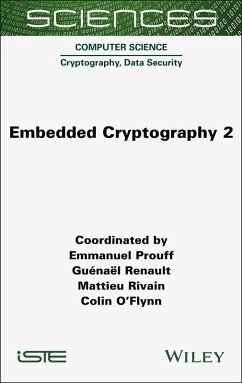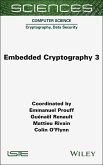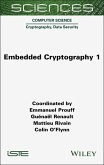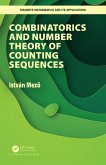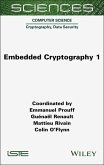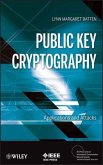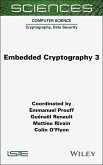Emmanuel Prouff, Guenael Renault, Mattieu Rivain, Colin O'Flynn
Embedded Cryptography 2 (eBook, ePUB)
142,99 €
142,99 €
inkl. MwSt.
Sofort per Download lieferbar

0 °P sammeln
142,99 €
Als Download kaufen

142,99 €
inkl. MwSt.
Sofort per Download lieferbar

0 °P sammeln
Jetzt verschenken
Alle Infos zum eBook verschenken
142,99 €
inkl. MwSt.
Sofort per Download lieferbar
Alle Infos zum eBook verschenken

0 °P sammeln
Emmanuel Prouff, Guenael Renault, Mattieu Rivain, Colin O'Flynn
Embedded Cryptography 2 (eBook, ePUB)
- Format: ePub
- Merkliste
- Auf die Merkliste
- Bewerten Bewerten
- Teilen
- Produkt teilen
- Produkterinnerung
- Produkterinnerung

Bitte loggen Sie sich zunächst in Ihr Kundenkonto ein oder registrieren Sie sich bei
bücher.de, um das eBook-Abo tolino select nutzen zu können.
Hier können Sie sich einloggen
Hier können Sie sich einloggen
Sie sind bereits eingeloggt. Klicken Sie auf 2. tolino select Abo, um fortzufahren.

Bitte loggen Sie sich zunächst in Ihr Kundenkonto ein oder registrieren Sie sich bei bücher.de, um das eBook-Abo tolino select nutzen zu können.
Embedded Cryptography provides a comprehensive exploration of cryptographic techniques tailored for embedded systems, addressing the growing importance of security in devices such as mobile systems and IoT. The books explore the evolution of embedded cryptography since its inception in the mid-90s and cover both theoretical and practical aspects, as well as discussing the implementation of cryptographic algorithms such as AES, RSA, ECC and post-quantum algorithms.
The work is structured into three volumes, spanning forty chapters and nine parts, and is enriched with pedagogical materials…mehr
- Geräte: eReader
- mit Kopierschutz
- eBook Hilfe
- Größe: 28.84MB
Andere Kunden interessierten sich auch für
![Embedded Cryptography 3 (eBook, ePUB) Embedded Cryptography 3 (eBook, ePUB)]() Emmanuel ProuffEmbedded Cryptography 3 (eBook, ePUB)142,99 €
Emmanuel ProuffEmbedded Cryptography 3 (eBook, ePUB)142,99 €![Embedded Cryptography 1 (eBook, ePUB) Embedded Cryptography 1 (eBook, ePUB)]() Emmanuel ProuffEmbedded Cryptography 1 (eBook, ePUB)142,99 €
Emmanuel ProuffEmbedded Cryptography 1 (eBook, ePUB)142,99 €![Combinatorics and Number Theory of Counting Sequences (eBook, ePUB) Combinatorics and Number Theory of Counting Sequences (eBook, ePUB)]() Istvan MezoCombinatorics and Number Theory of Counting Sequences (eBook, ePUB)45,95 €
Istvan MezoCombinatorics and Number Theory of Counting Sequences (eBook, ePUB)45,95 €![Embedded Cryptography 1 (eBook, PDF) Embedded Cryptography 1 (eBook, PDF)]() Emmanuel ProuffEmbedded Cryptography 1 (eBook, PDF)142,99 €
Emmanuel ProuffEmbedded Cryptography 1 (eBook, PDF)142,99 €![Public Key Cryptography (eBook, ePUB) Public Key Cryptography (eBook, ePUB)]() Lynn Margaret BattenPublic Key Cryptography (eBook, ePUB)80,99 €
Lynn Margaret BattenPublic Key Cryptography (eBook, ePUB)80,99 €![Handbook of Finite Fields (eBook, ePUB) Handbook of Finite Fields (eBook, ePUB)]() Gary L. MullenHandbook of Finite Fields (eBook, ePUB)127,95 €
Gary L. MullenHandbook of Finite Fields (eBook, ePUB)127,95 €![Embedded Cryptography 3 (eBook, PDF) Embedded Cryptography 3 (eBook, PDF)]() Emmanuel ProuffEmbedded Cryptography 3 (eBook, PDF)142,99 €
Emmanuel ProuffEmbedded Cryptography 3 (eBook, PDF)142,99 €-
-
-
Embedded Cryptography provides a comprehensive exploration of cryptographic techniques tailored for embedded systems, addressing the growing importance of security in devices such as mobile systems and IoT. The books explore the evolution of embedded cryptography since its inception in the mid-90s and cover both theoretical and practical aspects, as well as discussing the implementation of cryptographic algorithms such as AES, RSA, ECC and post-quantum algorithms.
The work is structured into three volumes, spanning forty chapters and nine parts, and is enriched with pedagogical materials and real-world case studies, designed for researchers, professionals, and students alike, offering insights into both foundational and advanced topics in the field.
Embedded Cryptography 2 is dedicated to masking and cryptographic implementations, as well as hardware security.
The work is structured into three volumes, spanning forty chapters and nine parts, and is enriched with pedagogical materials and real-world case studies, designed for researchers, professionals, and students alike, offering insights into both foundational and advanced topics in the field.
Embedded Cryptography 2 is dedicated to masking and cryptographic implementations, as well as hardware security.
Dieser Download kann aus rechtlichen Gründen nur mit Rechnungsadresse in D ausgeliefert werden.
Produktdetails
- Produktdetails
- Verlag: John Wiley & Sons
- Seitenzahl: 643
- Erscheinungstermin: 14. Januar 2025
- Englisch
- ISBN-13: 9781394351893
- Artikelnr.: 72854333
- Verlag: John Wiley & Sons
- Seitenzahl: 643
- Erscheinungstermin: 14. Januar 2025
- Englisch
- ISBN-13: 9781394351893
- Artikelnr.: 72854333
- Herstellerkennzeichnung Die Herstellerinformationen sind derzeit nicht verfügbar.
Emmanuel Prouff is a researcher in Applied Cryptography and Embedded Security. He has worked as an expert for ANSSI, France, as well as for major security companies such as IDEMIA and SAFRAN, both to develop secure implementations against physical attacks.
Guénaël Renault is Deputy Head of the Hardware Security Lab at ANSSI, France. His research interests include cryptography, algebraic (symbolic) computation and computational number theory.
Mattieu Rivain is a researcher and entrepreneur in Cryptography, currently working as CEO at CryptoExperts, France. His research interests include provable security against side-channel attacks, white-box cryptography, zero-knowledge proofs and post-quantum signatures.
Colin O'Flynn is Assistant Professor in Embedded Hardware Security at Dalhousie University, Canada. His interests include embedded hardware security, PCB design and prototype construction.
Guénaël Renault is Deputy Head of the Hardware Security Lab at ANSSI, France. His research interests include cryptography, algebraic (symbolic) computation and computational number theory.
Mattieu Rivain is a researcher and entrepreneur in Cryptography, currently working as CEO at CryptoExperts, France. His research interests include provable security against side-channel attacks, white-box cryptography, zero-knowledge proofs and post-quantum signatures.
Colin O'Flynn is Assistant Professor in Embedded Hardware Security at Dalhousie University, Canada. His interests include embedded hardware security, PCB design and prototype construction.
Preface xiii
Emmanuel PROUFF, Guénaël RENAULT, Matthieu RIVAIN and Colin O'FLYNN
Part 1 Masking 1
Chapter 1 Introduction to Masking 3
Ange MARTINELLI and Mélissa ROSSI
1.1. An overview of masking 3
1.2. The effect of masking on side-channel leakage 4
1.3. Different types of masking 5
1.4. Code-based masking: toward a generic framework 8
1.5. Hybrid masking 10
1.6. Examples of specific maskings 11
1.7. Outline of the part 12
1.8. Notes and further references 13
1.9. References 13
Chapter 2 Masking Schemes 15
Jean-Sébastien CORON and Rina ZEITOUN
2.1. Introduction to masking operations 15
2.2. Classical linear operations 15
2.3. Classical nonlinear operations 16
2.3.1 Application of ISW algorithm for n =2and n =3 17
2.4. Mask refreshing 18
2.4.1 Refresh masks with complexity O(n) 18
2.4.2 Refresh masks with complexity O(n 2) 18
2.4.3 Refresh masks with complexity O(n · log n) 19
2.5. Masking S-boxes 21
2.5.1. The Rivain-Prouff countermeasure for AES 21
2.5.2. Extension to any S-box 22
2.5.3. The randomized table countermeasure 23
2.5.4. Attacks 24
2.6. Masks conversions 27
2.6.1. First-order Boolean to arithmetic masking 27
2.6.2. Generalization to high order for Boolean to arithmetic masking 28
2.6.3. High order Boolean to arithmetic and arithmetic to Boolean masking
30
2.7. Notes and further references 35
2.8. References 37
Chapter 3 Hardware Masking 39
Begül BILGIN and Lauren DE MEYER
3.1. Introduction 39
3.1.1. Glitches 40
3.1.2. Glitch-extended probes 41
3.1.3. Non-completeness 41
3.2. Category I: td +1masking 42
3.2.1. First-order security 43
3.2.2. Higher-order security 46
3.3. Category II: d +1masking 46
3.3.1. General construction 47
3.3.2. Security argument 48
3.3.3. Comparing to td +1masking 49
3.3.4. Higher-degree functions 50
3.4. Trade-offs 51
3.4.1. Minimizing area 52
3.4.2. Minimizing latency 52
3.4.3. Minimizing randomness 53
3.5. Notes and further references 53
3.6. References 55
Chapter 4 Masking Security Proofs 59
Sonia BELAÏD
4.1. Introduction 59
4.2. Preliminaries 60
4.2.1. Circuits 60
4.2.2. Additive sharings and gadgets 61
4.2.3. Compilers 61
4.3. Probing model 62
4.3.1. Formal definition 62
4.3.2. Proofs for small gadgets 63
4.3.3. Simulation-based proofs 64
4.3.4. Limitations 66
4.4. Robust probing model 67
4.4.1. Formal definition 67
4.4.2. Proofs for small gadgets 68
4.4.3. Limitations 69
4.5. Random probing model and noisy leakage model 70
4.5.1. Formal definition of the noisy leakage model 70
4.5.2. Limitations 70
4.5.3. Reduction to the probing model 71
4.5.4. Formal definition of the random probing model 71
4.5.5. Proofs in the random probing model 72
4.5.6. Extension to handle physical defaults 73
4.6. Composition 74
4.6.1. Composition in the probing model 74
4.6.2. Composition in the random probing model 77
4.7. Conclusion 81
4.8. Notes and further references 81
4.9. References 81
Chapter 5 Masking Verification 83
Abdul Rahman TALEB
5.1. Introduction 83
5.2. General procedure 84
5.3. Verify: verification mechanisms for a set of variables 87
5.3.1 Distribution-based Verify 87
5.3.2 Simulation-based Verify 90
5.4. Explore: exploration mechanisms for all sets of variables 97
5.4.1. Probing model 98
5.4.2. Random probing model 102
5.4.3. Handling physical defaults 107
5.5. Conclusion 108
5.6. Notes and further references 109
5.7. Solution to Exercise 5.1 109
5.8. References 111
Part 2 Cryptographic Implementations 113
Chapter 6. Hardware Acceleration of Cryptographic Algorithms 115
Lejla BATINA, Pedro Maat COSTA MASSOLINO and Nele MENTENS
6.1. Introduction 115
6.2. Hardware optimization of symmetric-key cryptography 116
6.2.1. Hardware implementation of the AES S-box 117
6.2.2. Composite field based implementation of the AES S-box 117
6.3. Modular arithmetic for hardware implementations 118
6.3.1. Montgomery's arithmetic 119
6.3.2. Barret reduction 120
6.3.3. Implementations using residue number system 122
6.4. RSA implementations 123
6.4.1. Previous works on RSA implementations 123
6.4.2. ECC implementations over prime fields 124
6.5. Post-quantum cryptography 125
6.6. Conclusion 126
6.7. Notes and further references 127
6.8. References 128
Chapter 7 Constant-Time Implementations 133
Thomas PORNIN
7.1. What does constant-time mean? 133
7.1.1. Timing attacks 133
7.1.2. Applicability and importance 134
7.1.3. Example: rejection sampling 135
7.2. Low-level issues 138
7.2.1. CPU execution pipeline 138
7.2.2. Variable time instructions 140
7.2.3. Memory and caches 143
7.2.4. Jumps and jump prediction 145
7.3. Primitive implementation techniques 146
7.3.1. Compiler issues and Booleans 146
7.3.2. Bitwise Boolean logic 150
7.4. Constant-time algorithms 163
7.4.1. Modular integers 163
7.4.2. Modular exponentiation 166
7.4.3. Modular inversion 168
7.4.4. Elliptic curves 171
7.5. References 175
Chapter 8 Protected AES Implementations 177
Franck RONDEPIERRE
8.1. Generic countermeasures 178
8.1.1. 1 among N 178
8.1.2. Integrity 179
8.2. Secure evaluation of the SubByte function 180
8.2.1. S-box and inverse S-box 181
8.2.2. Security 182
8.2.3. Secure table lookup 183
8.2.4 Evaluation in F 2 8 184
8.2.5. Tower field 187
8.2.6. Bitslice S-box 188
8.2.7. How to select the S-box implementation 189
8.3. Other functions of AES 192
8.3.1. State 192
8.3.2. ShiftRow 192
8.3.3. MixColumn 192
8.3.4. KeyScheduling 193
8.3.5. AES inverse function 194
8.3.6. Key generation 194
8.3.7. Interface 195
8.3.8. Bitsliced state example 195
8.4. Notes and further references 197
8.5. References 198
Chapter 9 Protected RSA Implementations 201
Mylène ROUSSELLET, Yannick TEGLIA and David VIGILANT
9.1. Introduction 201
9.1.1. The RSA cryptosystem 201
9.1.2. RSA and security recommendations 201
9.1.3. RSA-CRT and straightforward mode 202
9.1.4. Toward a device product embedding RSA-CRT 203
9.2. Building a protected RSA implementation step by step 203
9.2.1. Loading RSA-CRT key parameter - Step 1 204
9.2.2. Message reductions - Step 2 205
9.2.3. Exponentiations - Step 3 206
9.2.4. Recombination - Step 4 211
9.2.5. Return S 212
9.2.6. Protected RSA-CRT pseudo-code 212
9.3. Remarks and open discussion 213
9.3.1. Security resistance consideration 213
9.4. Notes and further references 214
9.5. References 220
Chapter 10 Protected ECC Implementations 225
¿ukasz CHMIELEWSKI and Louiza PAPACHRISTODOULOU
10.1. Introduction 225
10.2. Protecting ECC implementations and countermeasures 226
10.2.1. Unified arithmetic and complete formulae 227
10.2.2. Constant-time scalar multiplication 228
10.2.3. Elimination of if-statements even dummy ones 230
10.2.4. Scalar randomization 234
10.2.5. Coordinate and point randomizations 236
10.2.6. Protection against address-bit side-channel attacks 238
10.2.7. Additional fault injection protections 241
10.3. Conclusion 242
10.4. Notes and further references 242
10.5. References 245
Chapter 11 Post-Quantum Implementations 249
Matthias J. KANNWISCHER, Ruben NIEDERHAGEN, Francisco RODRÍGUEZ-HENRÍQUEZ
and Peter SCHWABE
11.1. Introduction 249
11.2. Post-quantum encryption and key encapsulation 251
11.2.1. Lattice-based KEMs - Kyber 251
11.2.2. Code-based KEMs - Classic McEliece 256
11.2.3. Isogeny-based KEMs 259
11.2.4. IND-CCA2 security 263
11.3. Post-quantum signatures 265
11.3.1. Lattice-based signatures - Dilithium 266
11.3.2. Multivariate-quadratic-based signatures - UOV 269
11.3.3 Hash-based signatures - XMSS and SPHINCS + 272
11.4. Notes and further references 275
11.5. References 278
Part 3 Hardware Security 289
Chapter 12 Hardware Reverse Engineering and Invasive Attacks 291
Sergei SKOROBOGATOV
12.1. Introduction 291
12.2. Preparation for hardware attacks 291
12.2.1. Preparation at PCB level 292
12.2.2. Preparation at component level 295
12.2.3. Preparation at silicon level 299
12.3. Probing attacks 300
12.4. Delayering and reverse engineering 303
12.4.1. Chemical deprocessing 303
12.4.2. Mechanical deprocessing 304
12.4.3. Chemical-mechanical polishing (CMP) deprocessing 305
12.4.4. Plasma, RIE and FIB deprocessing 305
12.4.5. Staining techniques 306
12.4.6. From images to netlist 307
12.5. Memory dump and hardware cloning 309
12.6. Conclusion 311
12.7. Notes and further references 311
12.8. References 312
Chapter 13 Gate-Level Protection 315
Sylvain GUILLEY and Jean-Luc DANGER
13.1. Introduction 315
13.2. DPL principle, built-in DFA resistance, and latent side-channel
vulnerabilities 316
13.2.1. Information hiding rationale 316
13.2.2. DPL built-in DFA resistance 317
13.2.3. Vulnerabilities with respect to side-channel attacks 317
13.3. DPL families based on standard cells 318
13.3.1. WDDL 318
13.3.2. MDPL 319
13.3.3. DRSL 319
13.3.4. STTL 323
13.3.5. BCDL 323
13.3.6. WDDL variants 323
13.4. Technological specific DPL styles 328
13.4.1. Full custom optimizations 328
13.4.2. Asynchronous logic 330
13.4.3. Reversible differential logic 330
13.5. DPL styles comparison 331
13.6. Conclusion 331
13.7. Notes and further references 332
13.8. References 334
Chapter 14 Physically Unclonable Functions 339
Jean-Luc DANGER, Sylvain GUILLEY, Debdeep MUKHOPADHYAY and Ulrich RUHRMAIR
14.1. Introduction 339
14.1.1. Principle 339
14.1.2. The twin nature of PUFs 341
14.1.3. Properties 342
14.1.4. Two broad classification of PUFs 344
14.1.5. Necessity of enrollment 345
14.1.6. Use-cases 346
14.2. PUF architectures 347
14.2.1. Weak PUFs 347
14.2.2. Strong PUFs 350
14.2.3. Big picture of PUF architectures 353
14.3. Reliability enhancement 353
14.3.1. Use of error correcting codes 354
14.3.2. Discarding unreliable bits 356
14.3.3. Stochastic model of reliability 357
14.4. Entropy assessment 358
14.4.1. Stochastic model of the entropy 358
14.4.2. Entropy loss due to helper data 359
14.5. Resistance to attacks 361
14.5.1. Non-invasive attacks 361
14.5.2. Semi-invasive attacks 363
14.5.3. Invasive attacks 364
14.6. Characterizations 364
14.6.1. Reliability-aging 364
14.6.2. Machine learning attacks on challenge-response protocol 365
14.7. Standardization 365
14.7.1. International standards 365
14.7.2. Standards requiring PUF 366
14.8. Notes and further references 366
14.9. References 368
List of Authors 375
Index 379
Summary of Volume 1 385
Summary of Volume 3 393
Emmanuel PROUFF, Guénaël RENAULT, Matthieu RIVAIN and Colin O'FLYNN
Part 1 Masking 1
Chapter 1 Introduction to Masking 3
Ange MARTINELLI and Mélissa ROSSI
1.1. An overview of masking 3
1.2. The effect of masking on side-channel leakage 4
1.3. Different types of masking 5
1.4. Code-based masking: toward a generic framework 8
1.5. Hybrid masking 10
1.6. Examples of specific maskings 11
1.7. Outline of the part 12
1.8. Notes and further references 13
1.9. References 13
Chapter 2 Masking Schemes 15
Jean-Sébastien CORON and Rina ZEITOUN
2.1. Introduction to masking operations 15
2.2. Classical linear operations 15
2.3. Classical nonlinear operations 16
2.3.1 Application of ISW algorithm for n =2and n =3 17
2.4. Mask refreshing 18
2.4.1 Refresh masks with complexity O(n) 18
2.4.2 Refresh masks with complexity O(n 2) 18
2.4.3 Refresh masks with complexity O(n · log n) 19
2.5. Masking S-boxes 21
2.5.1. The Rivain-Prouff countermeasure for AES 21
2.5.2. Extension to any S-box 22
2.5.3. The randomized table countermeasure 23
2.5.4. Attacks 24
2.6. Masks conversions 27
2.6.1. First-order Boolean to arithmetic masking 27
2.6.2. Generalization to high order for Boolean to arithmetic masking 28
2.6.3. High order Boolean to arithmetic and arithmetic to Boolean masking
30
2.7. Notes and further references 35
2.8. References 37
Chapter 3 Hardware Masking 39
Begül BILGIN and Lauren DE MEYER
3.1. Introduction 39
3.1.1. Glitches 40
3.1.2. Glitch-extended probes 41
3.1.3. Non-completeness 41
3.2. Category I: td +1masking 42
3.2.1. First-order security 43
3.2.2. Higher-order security 46
3.3. Category II: d +1masking 46
3.3.1. General construction 47
3.3.2. Security argument 48
3.3.3. Comparing to td +1masking 49
3.3.4. Higher-degree functions 50
3.4. Trade-offs 51
3.4.1. Minimizing area 52
3.4.2. Minimizing latency 52
3.4.3. Minimizing randomness 53
3.5. Notes and further references 53
3.6. References 55
Chapter 4 Masking Security Proofs 59
Sonia BELAÏD
4.1. Introduction 59
4.2. Preliminaries 60
4.2.1. Circuits 60
4.2.2. Additive sharings and gadgets 61
4.2.3. Compilers 61
4.3. Probing model 62
4.3.1. Formal definition 62
4.3.2. Proofs for small gadgets 63
4.3.3. Simulation-based proofs 64
4.3.4. Limitations 66
4.4. Robust probing model 67
4.4.1. Formal definition 67
4.4.2. Proofs for small gadgets 68
4.4.3. Limitations 69
4.5. Random probing model and noisy leakage model 70
4.5.1. Formal definition of the noisy leakage model 70
4.5.2. Limitations 70
4.5.3. Reduction to the probing model 71
4.5.4. Formal definition of the random probing model 71
4.5.5. Proofs in the random probing model 72
4.5.6. Extension to handle physical defaults 73
4.6. Composition 74
4.6.1. Composition in the probing model 74
4.6.2. Composition in the random probing model 77
4.7. Conclusion 81
4.8. Notes and further references 81
4.9. References 81
Chapter 5 Masking Verification 83
Abdul Rahman TALEB
5.1. Introduction 83
5.2. General procedure 84
5.3. Verify: verification mechanisms for a set of variables 87
5.3.1 Distribution-based Verify 87
5.3.2 Simulation-based Verify 90
5.4. Explore: exploration mechanisms for all sets of variables 97
5.4.1. Probing model 98
5.4.2. Random probing model 102
5.4.3. Handling physical defaults 107
5.5. Conclusion 108
5.6. Notes and further references 109
5.7. Solution to Exercise 5.1 109
5.8. References 111
Part 2 Cryptographic Implementations 113
Chapter 6. Hardware Acceleration of Cryptographic Algorithms 115
Lejla BATINA, Pedro Maat COSTA MASSOLINO and Nele MENTENS
6.1. Introduction 115
6.2. Hardware optimization of symmetric-key cryptography 116
6.2.1. Hardware implementation of the AES S-box 117
6.2.2. Composite field based implementation of the AES S-box 117
6.3. Modular arithmetic for hardware implementations 118
6.3.1. Montgomery's arithmetic 119
6.3.2. Barret reduction 120
6.3.3. Implementations using residue number system 122
6.4. RSA implementations 123
6.4.1. Previous works on RSA implementations 123
6.4.2. ECC implementations over prime fields 124
6.5. Post-quantum cryptography 125
6.6. Conclusion 126
6.7. Notes and further references 127
6.8. References 128
Chapter 7 Constant-Time Implementations 133
Thomas PORNIN
7.1. What does constant-time mean? 133
7.1.1. Timing attacks 133
7.1.2. Applicability and importance 134
7.1.3. Example: rejection sampling 135
7.2. Low-level issues 138
7.2.1. CPU execution pipeline 138
7.2.2. Variable time instructions 140
7.2.3. Memory and caches 143
7.2.4. Jumps and jump prediction 145
7.3. Primitive implementation techniques 146
7.3.1. Compiler issues and Booleans 146
7.3.2. Bitwise Boolean logic 150
7.4. Constant-time algorithms 163
7.4.1. Modular integers 163
7.4.2. Modular exponentiation 166
7.4.3. Modular inversion 168
7.4.4. Elliptic curves 171
7.5. References 175
Chapter 8 Protected AES Implementations 177
Franck RONDEPIERRE
8.1. Generic countermeasures 178
8.1.1. 1 among N 178
8.1.2. Integrity 179
8.2. Secure evaluation of the SubByte function 180
8.2.1. S-box and inverse S-box 181
8.2.2. Security 182
8.2.3. Secure table lookup 183
8.2.4 Evaluation in F 2 8 184
8.2.5. Tower field 187
8.2.6. Bitslice S-box 188
8.2.7. How to select the S-box implementation 189
8.3. Other functions of AES 192
8.3.1. State 192
8.3.2. ShiftRow 192
8.3.3. MixColumn 192
8.3.4. KeyScheduling 193
8.3.5. AES inverse function 194
8.3.6. Key generation 194
8.3.7. Interface 195
8.3.8. Bitsliced state example 195
8.4. Notes and further references 197
8.5. References 198
Chapter 9 Protected RSA Implementations 201
Mylène ROUSSELLET, Yannick TEGLIA and David VIGILANT
9.1. Introduction 201
9.1.1. The RSA cryptosystem 201
9.1.2. RSA and security recommendations 201
9.1.3. RSA-CRT and straightforward mode 202
9.1.4. Toward a device product embedding RSA-CRT 203
9.2. Building a protected RSA implementation step by step 203
9.2.1. Loading RSA-CRT key parameter - Step 1 204
9.2.2. Message reductions - Step 2 205
9.2.3. Exponentiations - Step 3 206
9.2.4. Recombination - Step 4 211
9.2.5. Return S 212
9.2.6. Protected RSA-CRT pseudo-code 212
9.3. Remarks and open discussion 213
9.3.1. Security resistance consideration 213
9.4. Notes and further references 214
9.5. References 220
Chapter 10 Protected ECC Implementations 225
¿ukasz CHMIELEWSKI and Louiza PAPACHRISTODOULOU
10.1. Introduction 225
10.2. Protecting ECC implementations and countermeasures 226
10.2.1. Unified arithmetic and complete formulae 227
10.2.2. Constant-time scalar multiplication 228
10.2.3. Elimination of if-statements even dummy ones 230
10.2.4. Scalar randomization 234
10.2.5. Coordinate and point randomizations 236
10.2.6. Protection against address-bit side-channel attacks 238
10.2.7. Additional fault injection protections 241
10.3. Conclusion 242
10.4. Notes and further references 242
10.5. References 245
Chapter 11 Post-Quantum Implementations 249
Matthias J. KANNWISCHER, Ruben NIEDERHAGEN, Francisco RODRÍGUEZ-HENRÍQUEZ
and Peter SCHWABE
11.1. Introduction 249
11.2. Post-quantum encryption and key encapsulation 251
11.2.1. Lattice-based KEMs - Kyber 251
11.2.2. Code-based KEMs - Classic McEliece 256
11.2.3. Isogeny-based KEMs 259
11.2.4. IND-CCA2 security 263
11.3. Post-quantum signatures 265
11.3.1. Lattice-based signatures - Dilithium 266
11.3.2. Multivariate-quadratic-based signatures - UOV 269
11.3.3 Hash-based signatures - XMSS and SPHINCS + 272
11.4. Notes and further references 275
11.5. References 278
Part 3 Hardware Security 289
Chapter 12 Hardware Reverse Engineering and Invasive Attacks 291
Sergei SKOROBOGATOV
12.1. Introduction 291
12.2. Preparation for hardware attacks 291
12.2.1. Preparation at PCB level 292
12.2.2. Preparation at component level 295
12.2.3. Preparation at silicon level 299
12.3. Probing attacks 300
12.4. Delayering and reverse engineering 303
12.4.1. Chemical deprocessing 303
12.4.2. Mechanical deprocessing 304
12.4.3. Chemical-mechanical polishing (CMP) deprocessing 305
12.4.4. Plasma, RIE and FIB deprocessing 305
12.4.5. Staining techniques 306
12.4.6. From images to netlist 307
12.5. Memory dump and hardware cloning 309
12.6. Conclusion 311
12.7. Notes and further references 311
12.8. References 312
Chapter 13 Gate-Level Protection 315
Sylvain GUILLEY and Jean-Luc DANGER
13.1. Introduction 315
13.2. DPL principle, built-in DFA resistance, and latent side-channel
vulnerabilities 316
13.2.1. Information hiding rationale 316
13.2.2. DPL built-in DFA resistance 317
13.2.3. Vulnerabilities with respect to side-channel attacks 317
13.3. DPL families based on standard cells 318
13.3.1. WDDL 318
13.3.2. MDPL 319
13.3.3. DRSL 319
13.3.4. STTL 323
13.3.5. BCDL 323
13.3.6. WDDL variants 323
13.4. Technological specific DPL styles 328
13.4.1. Full custom optimizations 328
13.4.2. Asynchronous logic 330
13.4.3. Reversible differential logic 330
13.5. DPL styles comparison 331
13.6. Conclusion 331
13.7. Notes and further references 332
13.8. References 334
Chapter 14 Physically Unclonable Functions 339
Jean-Luc DANGER, Sylvain GUILLEY, Debdeep MUKHOPADHYAY and Ulrich RUHRMAIR
14.1. Introduction 339
14.1.1. Principle 339
14.1.2. The twin nature of PUFs 341
14.1.3. Properties 342
14.1.4. Two broad classification of PUFs 344
14.1.5. Necessity of enrollment 345
14.1.6. Use-cases 346
14.2. PUF architectures 347
14.2.1. Weak PUFs 347
14.2.2. Strong PUFs 350
14.2.3. Big picture of PUF architectures 353
14.3. Reliability enhancement 353
14.3.1. Use of error correcting codes 354
14.3.2. Discarding unreliable bits 356
14.3.3. Stochastic model of reliability 357
14.4. Entropy assessment 358
14.4.1. Stochastic model of the entropy 358
14.4.2. Entropy loss due to helper data 359
14.5. Resistance to attacks 361
14.5.1. Non-invasive attacks 361
14.5.2. Semi-invasive attacks 363
14.5.3. Invasive attacks 364
14.6. Characterizations 364
14.6.1. Reliability-aging 364
14.6.2. Machine learning attacks on challenge-response protocol 365
14.7. Standardization 365
14.7.1. International standards 365
14.7.2. Standards requiring PUF 366
14.8. Notes and further references 366
14.9. References 368
List of Authors 375
Index 379
Summary of Volume 1 385
Summary of Volume 3 393
Preface xiii
Emmanuel PROUFF, Guénaël RENAULT, Matthieu RIVAIN and Colin O'FLYNN
Part 1 Masking 1
Chapter 1 Introduction to Masking 3
Ange MARTINELLI and Mélissa ROSSI
1.1. An overview of masking 3
1.2. The effect of masking on side-channel leakage 4
1.3. Different types of masking 5
1.4. Code-based masking: toward a generic framework 8
1.5. Hybrid masking 10
1.6. Examples of specific maskings 11
1.7. Outline of the part 12
1.8. Notes and further references 13
1.9. References 13
Chapter 2 Masking Schemes 15
Jean-Sébastien CORON and Rina ZEITOUN
2.1. Introduction to masking operations 15
2.2. Classical linear operations 15
2.3. Classical nonlinear operations 16
2.3.1 Application of ISW algorithm for n =2and n =3 17
2.4. Mask refreshing 18
2.4.1 Refresh masks with complexity O(n) 18
2.4.2 Refresh masks with complexity O(n 2) 18
2.4.3 Refresh masks with complexity O(n · log n) 19
2.5. Masking S-boxes 21
2.5.1. The Rivain-Prouff countermeasure for AES 21
2.5.2. Extension to any S-box 22
2.5.3. The randomized table countermeasure 23
2.5.4. Attacks 24
2.6. Masks conversions 27
2.6.1. First-order Boolean to arithmetic masking 27
2.6.2. Generalization to high order for Boolean to arithmetic masking 28
2.6.3. High order Boolean to arithmetic and arithmetic to Boolean masking
30
2.7. Notes and further references 35
2.8. References 37
Chapter 3 Hardware Masking 39
Begül BILGIN and Lauren DE MEYER
3.1. Introduction 39
3.1.1. Glitches 40
3.1.2. Glitch-extended probes 41
3.1.3. Non-completeness 41
3.2. Category I: td +1masking 42
3.2.1. First-order security 43
3.2.2. Higher-order security 46
3.3. Category II: d +1masking 46
3.3.1. General construction 47
3.3.2. Security argument 48
3.3.3. Comparing to td +1masking 49
3.3.4. Higher-degree functions 50
3.4. Trade-offs 51
3.4.1. Minimizing area 52
3.4.2. Minimizing latency 52
3.4.3. Minimizing randomness 53
3.5. Notes and further references 53
3.6. References 55
Chapter 4 Masking Security Proofs 59
Sonia BELAÏD
4.1. Introduction 59
4.2. Preliminaries 60
4.2.1. Circuits 60
4.2.2. Additive sharings and gadgets 61
4.2.3. Compilers 61
4.3. Probing model 62
4.3.1. Formal definition 62
4.3.2. Proofs for small gadgets 63
4.3.3. Simulation-based proofs 64
4.3.4. Limitations 66
4.4. Robust probing model 67
4.4.1. Formal definition 67
4.4.2. Proofs for small gadgets 68
4.4.3. Limitations 69
4.5. Random probing model and noisy leakage model 70
4.5.1. Formal definition of the noisy leakage model 70
4.5.2. Limitations 70
4.5.3. Reduction to the probing model 71
4.5.4. Formal definition of the random probing model 71
4.5.5. Proofs in the random probing model 72
4.5.6. Extension to handle physical defaults 73
4.6. Composition 74
4.6.1. Composition in the probing model 74
4.6.2. Composition in the random probing model 77
4.7. Conclusion 81
4.8. Notes and further references 81
4.9. References 81
Chapter 5 Masking Verification 83
Abdul Rahman TALEB
5.1. Introduction 83
5.2. General procedure 84
5.3. Verify: verification mechanisms for a set of variables 87
5.3.1 Distribution-based Verify 87
5.3.2 Simulation-based Verify 90
5.4. Explore: exploration mechanisms for all sets of variables 97
5.4.1. Probing model 98
5.4.2. Random probing model 102
5.4.3. Handling physical defaults 107
5.5. Conclusion 108
5.6. Notes and further references 109
5.7. Solution to Exercise 5.1 109
5.8. References 111
Part 2 Cryptographic Implementations 113
Chapter 6. Hardware Acceleration of Cryptographic Algorithms 115
Lejla BATINA, Pedro Maat COSTA MASSOLINO and Nele MENTENS
6.1. Introduction 115
6.2. Hardware optimization of symmetric-key cryptography 116
6.2.1. Hardware implementation of the AES S-box 117
6.2.2. Composite field based implementation of the AES S-box 117
6.3. Modular arithmetic for hardware implementations 118
6.3.1. Montgomery's arithmetic 119
6.3.2. Barret reduction 120
6.3.3. Implementations using residue number system 122
6.4. RSA implementations 123
6.4.1. Previous works on RSA implementations 123
6.4.2. ECC implementations over prime fields 124
6.5. Post-quantum cryptography 125
6.6. Conclusion 126
6.7. Notes and further references 127
6.8. References 128
Chapter 7 Constant-Time Implementations 133
Thomas PORNIN
7.1. What does constant-time mean? 133
7.1.1. Timing attacks 133
7.1.2. Applicability and importance 134
7.1.3. Example: rejection sampling 135
7.2. Low-level issues 138
7.2.1. CPU execution pipeline 138
7.2.2. Variable time instructions 140
7.2.3. Memory and caches 143
7.2.4. Jumps and jump prediction 145
7.3. Primitive implementation techniques 146
7.3.1. Compiler issues and Booleans 146
7.3.2. Bitwise Boolean logic 150
7.4. Constant-time algorithms 163
7.4.1. Modular integers 163
7.4.2. Modular exponentiation 166
7.4.3. Modular inversion 168
7.4.4. Elliptic curves 171
7.5. References 175
Chapter 8 Protected AES Implementations 177
Franck RONDEPIERRE
8.1. Generic countermeasures 178
8.1.1. 1 among N 178
8.1.2. Integrity 179
8.2. Secure evaluation of the SubByte function 180
8.2.1. S-box and inverse S-box 181
8.2.2. Security 182
8.2.3. Secure table lookup 183
8.2.4 Evaluation in F 2 8 184
8.2.5. Tower field 187
8.2.6. Bitslice S-box 188
8.2.7. How to select the S-box implementation 189
8.3. Other functions of AES 192
8.3.1. State 192
8.3.2. ShiftRow 192
8.3.3. MixColumn 192
8.3.4. KeyScheduling 193
8.3.5. AES inverse function 194
8.3.6. Key generation 194
8.3.7. Interface 195
8.3.8. Bitsliced state example 195
8.4. Notes and further references 197
8.5. References 198
Chapter 9 Protected RSA Implementations 201
Mylène ROUSSELLET, Yannick TEGLIA and David VIGILANT
9.1. Introduction 201
9.1.1. The RSA cryptosystem 201
9.1.2. RSA and security recommendations 201
9.1.3. RSA-CRT and straightforward mode 202
9.1.4. Toward a device product embedding RSA-CRT 203
9.2. Building a protected RSA implementation step by step 203
9.2.1. Loading RSA-CRT key parameter - Step 1 204
9.2.2. Message reductions - Step 2 205
9.2.3. Exponentiations - Step 3 206
9.2.4. Recombination - Step 4 211
9.2.5. Return S 212
9.2.6. Protected RSA-CRT pseudo-code 212
9.3. Remarks and open discussion 213
9.3.1. Security resistance consideration 213
9.4. Notes and further references 214
9.5. References 220
Chapter 10 Protected ECC Implementations 225
¿ukasz CHMIELEWSKI and Louiza PAPACHRISTODOULOU
10.1. Introduction 225
10.2. Protecting ECC implementations and countermeasures 226
10.2.1. Unified arithmetic and complete formulae 227
10.2.2. Constant-time scalar multiplication 228
10.2.3. Elimination of if-statements even dummy ones 230
10.2.4. Scalar randomization 234
10.2.5. Coordinate and point randomizations 236
10.2.6. Protection against address-bit side-channel attacks 238
10.2.7. Additional fault injection protections 241
10.3. Conclusion 242
10.4. Notes and further references 242
10.5. References 245
Chapter 11 Post-Quantum Implementations 249
Matthias J. KANNWISCHER, Ruben NIEDERHAGEN, Francisco RODRÍGUEZ-HENRÍQUEZ
and Peter SCHWABE
11.1. Introduction 249
11.2. Post-quantum encryption and key encapsulation 251
11.2.1. Lattice-based KEMs - Kyber 251
11.2.2. Code-based KEMs - Classic McEliece 256
11.2.3. Isogeny-based KEMs 259
11.2.4. IND-CCA2 security 263
11.3. Post-quantum signatures 265
11.3.1. Lattice-based signatures - Dilithium 266
11.3.2. Multivariate-quadratic-based signatures - UOV 269
11.3.3 Hash-based signatures - XMSS and SPHINCS + 272
11.4. Notes and further references 275
11.5. References 278
Part 3 Hardware Security 289
Chapter 12 Hardware Reverse Engineering and Invasive Attacks 291
Sergei SKOROBOGATOV
12.1. Introduction 291
12.2. Preparation for hardware attacks 291
12.2.1. Preparation at PCB level 292
12.2.2. Preparation at component level 295
12.2.3. Preparation at silicon level 299
12.3. Probing attacks 300
12.4. Delayering and reverse engineering 303
12.4.1. Chemical deprocessing 303
12.4.2. Mechanical deprocessing 304
12.4.3. Chemical-mechanical polishing (CMP) deprocessing 305
12.4.4. Plasma, RIE and FIB deprocessing 305
12.4.5. Staining techniques 306
12.4.6. From images to netlist 307
12.5. Memory dump and hardware cloning 309
12.6. Conclusion 311
12.7. Notes and further references 311
12.8. References 312
Chapter 13 Gate-Level Protection 315
Sylvain GUILLEY and Jean-Luc DANGER
13.1. Introduction 315
13.2. DPL principle, built-in DFA resistance, and latent side-channel
vulnerabilities 316
13.2.1. Information hiding rationale 316
13.2.2. DPL built-in DFA resistance 317
13.2.3. Vulnerabilities with respect to side-channel attacks 317
13.3. DPL families based on standard cells 318
13.3.1. WDDL 318
13.3.2. MDPL 319
13.3.3. DRSL 319
13.3.4. STTL 323
13.3.5. BCDL 323
13.3.6. WDDL variants 323
13.4. Technological specific DPL styles 328
13.4.1. Full custom optimizations 328
13.4.2. Asynchronous logic 330
13.4.3. Reversible differential logic 330
13.5. DPL styles comparison 331
13.6. Conclusion 331
13.7. Notes and further references 332
13.8. References 334
Chapter 14 Physically Unclonable Functions 339
Jean-Luc DANGER, Sylvain GUILLEY, Debdeep MUKHOPADHYAY and Ulrich RUHRMAIR
14.1. Introduction 339
14.1.1. Principle 339
14.1.2. The twin nature of PUFs 341
14.1.3. Properties 342
14.1.4. Two broad classification of PUFs 344
14.1.5. Necessity of enrollment 345
14.1.6. Use-cases 346
14.2. PUF architectures 347
14.2.1. Weak PUFs 347
14.2.2. Strong PUFs 350
14.2.3. Big picture of PUF architectures 353
14.3. Reliability enhancement 353
14.3.1. Use of error correcting codes 354
14.3.2. Discarding unreliable bits 356
14.3.3. Stochastic model of reliability 357
14.4. Entropy assessment 358
14.4.1. Stochastic model of the entropy 358
14.4.2. Entropy loss due to helper data 359
14.5. Resistance to attacks 361
14.5.1. Non-invasive attacks 361
14.5.2. Semi-invasive attacks 363
14.5.3. Invasive attacks 364
14.6. Characterizations 364
14.6.1. Reliability-aging 364
14.6.2. Machine learning attacks on challenge-response protocol 365
14.7. Standardization 365
14.7.1. International standards 365
14.7.2. Standards requiring PUF 366
14.8. Notes and further references 366
14.9. References 368
List of Authors 375
Index 379
Summary of Volume 1 385
Summary of Volume 3 393
Emmanuel PROUFF, Guénaël RENAULT, Matthieu RIVAIN and Colin O'FLYNN
Part 1 Masking 1
Chapter 1 Introduction to Masking 3
Ange MARTINELLI and Mélissa ROSSI
1.1. An overview of masking 3
1.2. The effect of masking on side-channel leakage 4
1.3. Different types of masking 5
1.4. Code-based masking: toward a generic framework 8
1.5. Hybrid masking 10
1.6. Examples of specific maskings 11
1.7. Outline of the part 12
1.8. Notes and further references 13
1.9. References 13
Chapter 2 Masking Schemes 15
Jean-Sébastien CORON and Rina ZEITOUN
2.1. Introduction to masking operations 15
2.2. Classical linear operations 15
2.3. Classical nonlinear operations 16
2.3.1 Application of ISW algorithm for n =2and n =3 17
2.4. Mask refreshing 18
2.4.1 Refresh masks with complexity O(n) 18
2.4.2 Refresh masks with complexity O(n 2) 18
2.4.3 Refresh masks with complexity O(n · log n) 19
2.5. Masking S-boxes 21
2.5.1. The Rivain-Prouff countermeasure for AES 21
2.5.2. Extension to any S-box 22
2.5.3. The randomized table countermeasure 23
2.5.4. Attacks 24
2.6. Masks conversions 27
2.6.1. First-order Boolean to arithmetic masking 27
2.6.2. Generalization to high order for Boolean to arithmetic masking 28
2.6.3. High order Boolean to arithmetic and arithmetic to Boolean masking
30
2.7. Notes and further references 35
2.8. References 37
Chapter 3 Hardware Masking 39
Begül BILGIN and Lauren DE MEYER
3.1. Introduction 39
3.1.1. Glitches 40
3.1.2. Glitch-extended probes 41
3.1.3. Non-completeness 41
3.2. Category I: td +1masking 42
3.2.1. First-order security 43
3.2.2. Higher-order security 46
3.3. Category II: d +1masking 46
3.3.1. General construction 47
3.3.2. Security argument 48
3.3.3. Comparing to td +1masking 49
3.3.4. Higher-degree functions 50
3.4. Trade-offs 51
3.4.1. Minimizing area 52
3.4.2. Minimizing latency 52
3.4.3. Minimizing randomness 53
3.5. Notes and further references 53
3.6. References 55
Chapter 4 Masking Security Proofs 59
Sonia BELAÏD
4.1. Introduction 59
4.2. Preliminaries 60
4.2.1. Circuits 60
4.2.2. Additive sharings and gadgets 61
4.2.3. Compilers 61
4.3. Probing model 62
4.3.1. Formal definition 62
4.3.2. Proofs for small gadgets 63
4.3.3. Simulation-based proofs 64
4.3.4. Limitations 66
4.4. Robust probing model 67
4.4.1. Formal definition 67
4.4.2. Proofs for small gadgets 68
4.4.3. Limitations 69
4.5. Random probing model and noisy leakage model 70
4.5.1. Formal definition of the noisy leakage model 70
4.5.2. Limitations 70
4.5.3. Reduction to the probing model 71
4.5.4. Formal definition of the random probing model 71
4.5.5. Proofs in the random probing model 72
4.5.6. Extension to handle physical defaults 73
4.6. Composition 74
4.6.1. Composition in the probing model 74
4.6.2. Composition in the random probing model 77
4.7. Conclusion 81
4.8. Notes and further references 81
4.9. References 81
Chapter 5 Masking Verification 83
Abdul Rahman TALEB
5.1. Introduction 83
5.2. General procedure 84
5.3. Verify: verification mechanisms for a set of variables 87
5.3.1 Distribution-based Verify 87
5.3.2 Simulation-based Verify 90
5.4. Explore: exploration mechanisms for all sets of variables 97
5.4.1. Probing model 98
5.4.2. Random probing model 102
5.4.3. Handling physical defaults 107
5.5. Conclusion 108
5.6. Notes and further references 109
5.7. Solution to Exercise 5.1 109
5.8. References 111
Part 2 Cryptographic Implementations 113
Chapter 6. Hardware Acceleration of Cryptographic Algorithms 115
Lejla BATINA, Pedro Maat COSTA MASSOLINO and Nele MENTENS
6.1. Introduction 115
6.2. Hardware optimization of symmetric-key cryptography 116
6.2.1. Hardware implementation of the AES S-box 117
6.2.2. Composite field based implementation of the AES S-box 117
6.3. Modular arithmetic for hardware implementations 118
6.3.1. Montgomery's arithmetic 119
6.3.2. Barret reduction 120
6.3.3. Implementations using residue number system 122
6.4. RSA implementations 123
6.4.1. Previous works on RSA implementations 123
6.4.2. ECC implementations over prime fields 124
6.5. Post-quantum cryptography 125
6.6. Conclusion 126
6.7. Notes and further references 127
6.8. References 128
Chapter 7 Constant-Time Implementations 133
Thomas PORNIN
7.1. What does constant-time mean? 133
7.1.1. Timing attacks 133
7.1.2. Applicability and importance 134
7.1.3. Example: rejection sampling 135
7.2. Low-level issues 138
7.2.1. CPU execution pipeline 138
7.2.2. Variable time instructions 140
7.2.3. Memory and caches 143
7.2.4. Jumps and jump prediction 145
7.3. Primitive implementation techniques 146
7.3.1. Compiler issues and Booleans 146
7.3.2. Bitwise Boolean logic 150
7.4. Constant-time algorithms 163
7.4.1. Modular integers 163
7.4.2. Modular exponentiation 166
7.4.3. Modular inversion 168
7.4.4. Elliptic curves 171
7.5. References 175
Chapter 8 Protected AES Implementations 177
Franck RONDEPIERRE
8.1. Generic countermeasures 178
8.1.1. 1 among N 178
8.1.2. Integrity 179
8.2. Secure evaluation of the SubByte function 180
8.2.1. S-box and inverse S-box 181
8.2.2. Security 182
8.2.3. Secure table lookup 183
8.2.4 Evaluation in F 2 8 184
8.2.5. Tower field 187
8.2.6. Bitslice S-box 188
8.2.7. How to select the S-box implementation 189
8.3. Other functions of AES 192
8.3.1. State 192
8.3.2. ShiftRow 192
8.3.3. MixColumn 192
8.3.4. KeyScheduling 193
8.3.5. AES inverse function 194
8.3.6. Key generation 194
8.3.7. Interface 195
8.3.8. Bitsliced state example 195
8.4. Notes and further references 197
8.5. References 198
Chapter 9 Protected RSA Implementations 201
Mylène ROUSSELLET, Yannick TEGLIA and David VIGILANT
9.1. Introduction 201
9.1.1. The RSA cryptosystem 201
9.1.2. RSA and security recommendations 201
9.1.3. RSA-CRT and straightforward mode 202
9.1.4. Toward a device product embedding RSA-CRT 203
9.2. Building a protected RSA implementation step by step 203
9.2.1. Loading RSA-CRT key parameter - Step 1 204
9.2.2. Message reductions - Step 2 205
9.2.3. Exponentiations - Step 3 206
9.2.4. Recombination - Step 4 211
9.2.5. Return S 212
9.2.6. Protected RSA-CRT pseudo-code 212
9.3. Remarks and open discussion 213
9.3.1. Security resistance consideration 213
9.4. Notes and further references 214
9.5. References 220
Chapter 10 Protected ECC Implementations 225
¿ukasz CHMIELEWSKI and Louiza PAPACHRISTODOULOU
10.1. Introduction 225
10.2. Protecting ECC implementations and countermeasures 226
10.2.1. Unified arithmetic and complete formulae 227
10.2.2. Constant-time scalar multiplication 228
10.2.3. Elimination of if-statements even dummy ones 230
10.2.4. Scalar randomization 234
10.2.5. Coordinate and point randomizations 236
10.2.6. Protection against address-bit side-channel attacks 238
10.2.7. Additional fault injection protections 241
10.3. Conclusion 242
10.4. Notes and further references 242
10.5. References 245
Chapter 11 Post-Quantum Implementations 249
Matthias J. KANNWISCHER, Ruben NIEDERHAGEN, Francisco RODRÍGUEZ-HENRÍQUEZ
and Peter SCHWABE
11.1. Introduction 249
11.2. Post-quantum encryption and key encapsulation 251
11.2.1. Lattice-based KEMs - Kyber 251
11.2.2. Code-based KEMs - Classic McEliece 256
11.2.3. Isogeny-based KEMs 259
11.2.4. IND-CCA2 security 263
11.3. Post-quantum signatures 265
11.3.1. Lattice-based signatures - Dilithium 266
11.3.2. Multivariate-quadratic-based signatures - UOV 269
11.3.3 Hash-based signatures - XMSS and SPHINCS + 272
11.4. Notes and further references 275
11.5. References 278
Part 3 Hardware Security 289
Chapter 12 Hardware Reverse Engineering and Invasive Attacks 291
Sergei SKOROBOGATOV
12.1. Introduction 291
12.2. Preparation for hardware attacks 291
12.2.1. Preparation at PCB level 292
12.2.2. Preparation at component level 295
12.2.3. Preparation at silicon level 299
12.3. Probing attacks 300
12.4. Delayering and reverse engineering 303
12.4.1. Chemical deprocessing 303
12.4.2. Mechanical deprocessing 304
12.4.3. Chemical-mechanical polishing (CMP) deprocessing 305
12.4.4. Plasma, RIE and FIB deprocessing 305
12.4.5. Staining techniques 306
12.4.6. From images to netlist 307
12.5. Memory dump and hardware cloning 309
12.6. Conclusion 311
12.7. Notes and further references 311
12.8. References 312
Chapter 13 Gate-Level Protection 315
Sylvain GUILLEY and Jean-Luc DANGER
13.1. Introduction 315
13.2. DPL principle, built-in DFA resistance, and latent side-channel
vulnerabilities 316
13.2.1. Information hiding rationale 316
13.2.2. DPL built-in DFA resistance 317
13.2.3. Vulnerabilities with respect to side-channel attacks 317
13.3. DPL families based on standard cells 318
13.3.1. WDDL 318
13.3.2. MDPL 319
13.3.3. DRSL 319
13.3.4. STTL 323
13.3.5. BCDL 323
13.3.6. WDDL variants 323
13.4. Technological specific DPL styles 328
13.4.1. Full custom optimizations 328
13.4.2. Asynchronous logic 330
13.4.3. Reversible differential logic 330
13.5. DPL styles comparison 331
13.6. Conclusion 331
13.7. Notes and further references 332
13.8. References 334
Chapter 14 Physically Unclonable Functions 339
Jean-Luc DANGER, Sylvain GUILLEY, Debdeep MUKHOPADHYAY and Ulrich RUHRMAIR
14.1. Introduction 339
14.1.1. Principle 339
14.1.2. The twin nature of PUFs 341
14.1.3. Properties 342
14.1.4. Two broad classification of PUFs 344
14.1.5. Necessity of enrollment 345
14.1.6. Use-cases 346
14.2. PUF architectures 347
14.2.1. Weak PUFs 347
14.2.2. Strong PUFs 350
14.2.3. Big picture of PUF architectures 353
14.3. Reliability enhancement 353
14.3.1. Use of error correcting codes 354
14.3.2. Discarding unreliable bits 356
14.3.3. Stochastic model of reliability 357
14.4. Entropy assessment 358
14.4.1. Stochastic model of the entropy 358
14.4.2. Entropy loss due to helper data 359
14.5. Resistance to attacks 361
14.5.1. Non-invasive attacks 361
14.5.2. Semi-invasive attacks 363
14.5.3. Invasive attacks 364
14.6. Characterizations 364
14.6.1. Reliability-aging 364
14.6.2. Machine learning attacks on challenge-response protocol 365
14.7. Standardization 365
14.7.1. International standards 365
14.7.2. Standards requiring PUF 366
14.8. Notes and further references 366
14.9. References 368
List of Authors 375
Index 379
Summary of Volume 1 385
Summary of Volume 3 393
